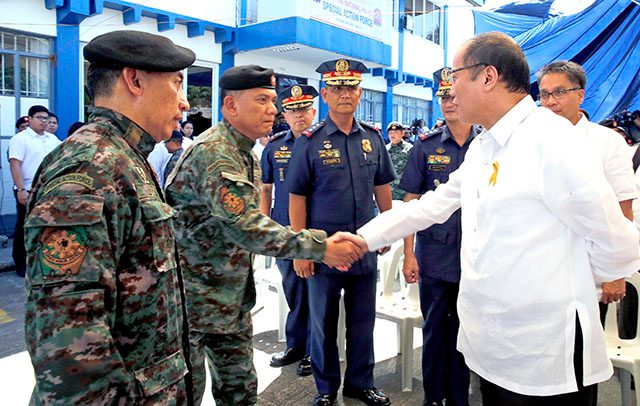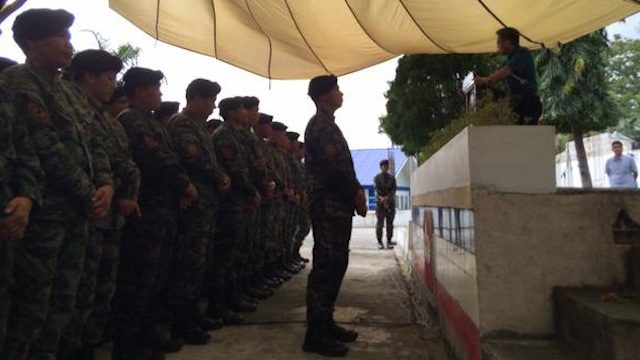SUMMARY
This is AI generated summarization, which may have errors. For context, always refer to the full article.

MANILA, Philippines (UPDATED) – More than a month after losing 44 of their men in a bloody police operation in Mamasapano town, Maguindanao, members of the Philippine National Police (PNP)’s elite Special Action Force (SAF) met behind closed doors with President Benigno Aquino III.
On Wednesday, March 4, they openly talked about the issue – which is far different from the time they gave the President silent treatment – in a meeting that began past 10 am Wednesday and ended past 1 pm.
They were joined by the PNP’s top generals, Interior Secretary Manuel Roxas II, and members of the President’s team.
During the meeting, members of the SAF spoke to Aquino about ways to move the beleaguered elite force forward: from improving their equipment and increasing their hazard pay to fixing their rotation schedules.
SAF troopers also did not shy away from questions about the controversial Mamasapano operation.
“The SAF troopers were told: if you have questions, ask them now,” said a Rappler source present during the meeting.
The elite commandos asked Aquino to clarify reports that it was because of his orders that prompted the AFP to stand down, and refuse to fire artillery even if the SAF troopers trapped in the area had already asked for it.
Aquino denied this. The President also pointed out what little he knew of the operation on January 25, according to one source.
Aquino also showed SAF troopers in the meeting the series of text messages between him and resigned PNP chief Alan Purisima that day, according to at least 2 Rappler sources present during the meeting.
SAF troopers, in return, told the President what happened in Mamasapano. Commanders also explained what decisions were made on the ground and why they were made.
“It was all tactical decisions. It was like a debriefing between the President and SAF,” said a police source of the hours-long meeting.
In a Thursday, March 5 briefing with reporters, presidential spokesman Secretary Herminio Coloma said Aquino’s reasons for visiting the police camp was “primarily to conduct or to preside over this operations review and thereafter to personally witness the turnover ceremony [between PNP OIC Chief Superintendent Noli Taliño and acting SAF commander Chief Superintendent Moro Lazo].”
Questions that linger
After members of the SAF’s 84th Seaborne Company killed terrorist Zulkifli bin Hir (alias “Marwan”) on January 25, its troopers and those from the 55th Special Action Company found themselves in battle with fighters from the Moro Islamic Liberation Front (MILF), the breakaway Bangsamoro Islamic Freedom Fighters (BIFF) and private armed groups.
With the military kept out of the loop in the planning stages of the operation, army troops were unaware of the situation inside. Although artillery and machinery support was available as early as 7 to 8 am on January 25, the military was unable to fire anything until almost 12 hours after.
SAF troopers wanted to know why, said newly assigned SAF commander Chief Superintendent Moro Lazo, who was in the meeting.
Troop support – or the lack thereof – is a touchy topic for the SAF, the PNP, and the Armed Forces of the Philippines (AFP), who have figured in a word war over the issue. SAF officials insist more could have been done while the AFP said it could not have moved given the dearth of information available at that time.
Why no speech?
Police sources present during the meeting denied rumors that voices were raised during the discussion or that a shouting match occurred between government officials and SAF troopers.
But one SAF trooper turned emotional as his voice started to rise. “We thought he was angry and were worried that he’d start shouting,” said the source.
The SAF trooper, a Saranggani native, turned out to be thanking the President for his push for peace in Muslim Mindanao. “He wanted to thank the President because he knows how difficult it is to be at war. He’s a Mindanao local and he’s a man in uniform. He also wondered why people were asking the government to scrap the peace deal,” said the source, who asked not to be quoted.
Coloma, meanwhile, emphasized that it was not in Aquino’s character to have “emotional outbursts.”
“Ni pagtataas boses o pagpapahayag ng emosyon, wala naman sigurong nakakapansin o makapagsasabi na iyan ay bahagi ng kanyang kinaugalian. Kaya walang batayan ang mga haka-haka at espekulasyon hinggil diyan,” added Coloma, referring to reports alleging otherwise.
(He does not raise his voice nor does he show emotion. People close to him will tell it’s not in his character to be overtaken by emotion. Those news reports have no basis.)
Aquino was also scheduled to deliver a speech during the installation of Lazo as the new SAF commander SAF that day.
But the speech was omitted from a brochure handed out by the SAF at the venue. An advisory from Malacañang sent hours before the 10 am meeting with the SAF also omitted the President’s speech.
One source said the decision to forgo the speech came from the President himself with some convincing “from the people around him.”
The source, explaining the decision, said it was a matter of “less talk, less mistake.”
The President’s previous speeches on Mamasapano, after all, did not sit well with the public.
What the SAF wants
In media interviews at Bagong Diwa, both Roxas and PNP officer-in-charge Deputy Director General Leonardo Espina said discussions revolved around how the SAF would move forward.
The elite forces’ commanders told the President they want the SAF to be a unit completely capable of launching its own operations without any help needed from better-equipped forces such as the military.
Among their wishes? Their own tanks, artillery, and air assets.
As the PNP’s elite mobile unit and striking force, the SAF is usually tapped for a wide range of missions: from high-level anti-terrorism operations to disaster response.
SAF was among the units that responded during the 2013 Zamboanga siege. SAF troopers were also flown into Tacloban City in the aftermath of Super Typhoon Yolanda to restore peace and order in the Leyte capital. – with a report from Natashya Gutierrez/Rappler.com
Add a comment
How does this make you feel?
 SAF trooper: We need government protection too
SAF trooper: We need government protection too
There are no comments yet. Add your comment to start the conversation.